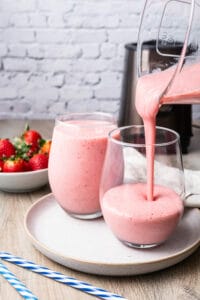If you have a secret recipe or an article perfect for sharing on our blog section, don't hesitate to let us know at [email protected] -- everyone has something extraordinary to offer and we can't wait to hear yours! Join us as we explore delicious flavors around the globe!
For now, love yourself and enjoy this one ...
Now love yourself and enjoy this one ...
Whip up this easy, creamy almond milk smoothie for a dairy-free treat everyone will love

Table of Contents
I can’t remember the last time I drank dairy milk. For whatever reason, dairy and I just don’t mix. No, I’m not lactose intolerant, but for some reason, my stomach just doesn’t like milk. Thank goodness we live in the day and age of dairy alternatives! My almond milk smoothie tricks my brain and my tastebuds into thinking I’m taking a sip of the good stuff. Even my dairy-loving friends and family enjoy these smoothies.
You’d be surprised by how creamy this almond milk smoothie tastes. That’s partially due to the banana and ice, which convinces my kids to think they’re drinking a strawberry milkshake. Aside from its delicious taste, it’s super simple to make. I have more complicated strawberry smoothie recipes, but this one is quick and easy, perfect for chaotic mornings and midday snacks.
Are Almond Milk Smoothies Healthy?
This simple almond milk smoothie recipe only contains a few ingredients, and each one is healthy in its own right. Almond milk is often fortified with calcium and is naturally rich in magnesium, a mineral that many of us with Western diets don’t get. Bananas come packed with potassium and pectin, a fiber that helps reduce constipation. And strawberries? They’re a trove of vitamins and minerals like vitamin C, manganese, and folate.
However, the key ingredient here, almond milk, is not for everyone. Whether you suffer from a nut allergy or would like to make this smoothie even creamier, you could always swap the almond milk for oat milk. What I like about oat milk is that it has a dairy-like taste. But please make sure there’s no added sugar, as oat milk is naturally sweet.
The Case for the Overripe Banana
Everyone knows that you need to use a ripe banana when your smoothie recipe calls for it. And that’s totally fine. However, since this almond milk smoothie doesn’t use any sugar, consider letting your bananas sit out a little while longer. I’ve found that overripe bananas are much sweeter, and this natural sugar is much healthier than the refined varieties. I will say that overripe bananas taste more “banana-y,” so you may want to add more strawberries to balance the flavor.
INGREDIENTS
- 2 cups frozen strawberries
- 2 ripe bananas
- 2/3 cup unsweetened almond milk
- 8 ice cubes
- 1 tablespoon almond butter optional

INSTRUCTIONS
Blend
Add strawberries, bananas, almond milk, ice, and almond butter into a blender. Blend until smooth.
Enjoy
Serve the smoothie fresh or keep it chilled.
Devour!

FAQs & Tips
Make the smoothie as the recipe instructs, and then pour it into an airtight container to prevent oxidation. Also, keep it very cold. You’ll want to store the smoothie in the back of your fridge. Fresh smoothies degrade fast, so I’d enjoy this smoothie within a day or two after making it. You could also freeze the smoothie using ice cube trays. This will make it easier to blend and store.
Really, any nut-based butter will work. I particularly like the creamy taste of cashew butter, but regular peanut butter works as well, and it’s much cheaper. If you’re avoiding nuts, you could always use sunflower butter, too.
Absolutely! I do this all the time. For one, frozen strawberries tend to be less expensive, and you can buy them in bulk. Using frozen strawberries will also naturally thicken the smoothie, making it the perfect cool treat on hot summer days.
Depending on the protein powder, I doubt it will. Plant-based protein powders are especially flavorless, so I’d go vegan if you want to keep the taste neutral.

Serving Suggestions
Personally, I enjoy this smoothie on its own, but it also pairs well with a protein-packed breakfast, like some easy-baked eggs in avocado. And if you’re keeping it vegan, this easy tofu scramble recipe is delicious, too. You can also pair it with a handful of trail mix energy bites for a mid-day snack.

Almond Milk Smoothie
Ingredients
- 2 cups frozen strawberries
- 2 ripe bananas
- 2/3 cup unsweetened almond milk
- 8 ice cubes
- 1 tablespoon almond butter optional
Instructions
- Combine the frozen strawberries, bananas broken into chunks, almond milk, ice cubes, and optional almond butter in a blender.

- Blend on high speed until the mixture is smooth and creamy.

- Pour the smoothie into glasses and enjoy immediately, or store in a covered jar in the refrigerator for up to 2 days.

- DEVOUR!
Nutrition
The post Almond Milk Smoothie appeared first on Food Faith Fitness.
References:
By: FoodfaithfitnessTitle: Almond Milk Smoothie
Sourced From: www.foodfaithfitness.com/almond-milk-smoothie/
Published Date: Wed, 06 Mar 2024 11:21:07 +0000
Frequently Asked Questions
What are the advantages of organic farming?
Organic farming gives farmers the opportunity to grow food without the use of chemical pesticides. Farmers do not need to worry about harmful pesticides harming their crops or animals.
Organic farming can also use natural fertilizers. These fertilizers promote healthy plants and decrease the amount of chemicals used.
Organic farming is also sustainable. To recycle nutrients back into soil, farmers often resort to composting. This reduces the risk of pollution and helps conserve precious resources.
As well as helping the environment, organic farming increases crop yields. This is because organic farming requires less water to grow the crops.
Organic production methods also mean that farmers receive higher prices for their produce. Healthier foods are demanded by consumers who are more aware of the dangers posed by pesticides and chemical fertilisers.
This raises the demand to produce organic food products. Organic farming is growing in popularity.
Which organic vegetables are best?
Organic vegetables are the best and most nutritious food source. They are the healthiest of all foods.
Organic produce is produced without pesticides or herbicides. These chemicals pose severe dangers to our health as well as the environment.
Organic produce contains more nutrients, vitamins and minerals. Organic produce is more nutritious and healthier.
Organic vegetables taste great and are safe to eat. Consuming organic produce has no known side effects.
All grocery stores can carry organic produce. You can find organic fruits and vegetables at all grocery stores as long as they conform to USDA guidelines.
Is organic a guarantee that the product is pesticide-free
Organic food is naturally chemical-free and grows without pesticides. This means that organic food is often free of pesticides and fertilizers.
Organic produce contains more nutrients and is healthier than conventionally manufactured foods, as it does not contain any harmful additives.
The USDA National Organic Program (NOP) requires farmers to follow strict guidelines for growing crops certified as organic.
These guidelines include soil preparation, crop rotating, pest control and water conservation.
Organic farming methods are also beneficial for wildlife and natural habitats.
What is the difference between organic and inorganic foods?
Organic food is grown without the use of pesticides or chemical fertilizers, sewage effluent, radiation, or genetic modification. Organic farming practices improve soil health and water quality as well as animal welfare.
Inorganic food is grown with pesticides and chemical fertilizers. Radiated foods are those that have been exposed to radiation. Genetically modified organisms, or GMOs, are created using biological engineering techniques.
Sometimes, the term "natural", is used interchangeably with "organic." However, natural does not necessarily mean organic. Products labelled "natural", however, may contain synthetic chemicals.
Organic produce is typically more nutritious than conventional produce because the soil contains fewer harmful chemicals and pesticides. Organic farmers also don't use synthetic fertilizers or hormones, pesticides, or antibiotics.
What does it mean to be an organic food producer?
Organic food producers create products that are grown without pesticides and chemical fertilizers. These foods include fruits, vegetables and dairy products.
When crops are naturally nurtured, organic food production can be achieved. This includes soil preparation, crop rotation, and pest management.
The USDA (United States Department of Agriculture), must set strict criteria for organic agricultural products.
These guidelines are designed to ensure consumers have access to safe, healthy and nutritious food.
Organic food offers many health benefits. From lower levels of pesticide residues, heavy metal contamination, to higher nutrient contents and better flavour, organic foods are healthier.
USDA organic products must carry the USDA Certified Organic seal.
This certification indicates that the product meets the requirements of the National Organic Program.
Organic food is not only healthier for us, but also protects our environment.
Organic farming methods help conserve natural resources like water and land. Additionally, organic farming methods help reduce greenhouse gas emission, which can lead to climate change.
Organic agriculture uses fewer chemicals, and less pollution runoff.
It also improves air quality because harmful gases like ammonia and nitrates are less likely to build up in the atmosphere.
There are many kinds of organic farming: permaculture, regenerative and conventional.
Conventional farming involves the use artificial inputs such as fertilizers and pesticides.
Regenerative farming involves compost, cover crops, and green manures to improve soil health. It also encourages biodiversity.
Agroecology is concerned with sustainable relationships between humans, plants, animals, and the environment.
Permaculture promotes self-sufficiency through the design of systems that mimic nature.
Statistics
- When packaged products indicate they are “made with organic [specific ingredient or food group],” they contain at least 70% organically produced ingredients. (usda.gov)
- Popular clothing brands, like Patagonia, are labelled as organic by using 100 percent organic cotton for many of their styles. (en.wikipedia.org)
- Brands participating in this challenge are committed to using 100 percent sustainable cotton by 2025.[5] (en.wikipedia.org)
- Cosmetic brands such as Laurel and Rose Mira are 100 percent organic and have a wide array of skincare products. (en.wikipedia.org)
External Links
[TAG34]
[TAG37]
- Evaluation of the micronutrient composition of plant foods produced by organic and conventional agricultural methods - PubMed
- Comparison of the total ascorbic and phenolic acid contents of air-dried and freeze-dried marionberry, strawberry and corn grown using conventional, organic and sustainable agricultural practices – PubMed
[TAG40]
- Occupational Pesticide Exposures and Cancer risk: A Review: Journal of Toxicology and Environmental Health Part B Vol 15, No 4
- Genetically modified foods: Safety, Risks and Public Concerns - A Review - Journal of Food Science and Technology
[TAG43]
How To
5 Reasons to Buy Organic Products
Organic food is grown without synthetic fertilizers and pesticides. They do not contain genetically modified organisms (GMOs), or radioactive ingredients. They are not made with sewage sludge, industrial solvents, or any other chemical substances. During its growing cycle, the food's natural environment will be protected from contamination. It is free from artificial additives and preservatives. There is no use hormones or anti-biotics. In addition, they are produced under conditions that allow them to retain their nutritional value and freshness for longer periods.
- Health benefits. Nonorganic produce has more chemicals than organic. Organic produce is healthier. This makes it less likely to cause allergies or sensitivities. This also means that you are consuming less toxins and carcinogens.
- Eco-friendliness. Organic produce is low in water consumption. Organic farms are typically located far away form areas of high pollution and where conventional growth is difficult because it requires so much effort. That helps reduce air pollution.
- Sustainability. Organic farming relies on soil fertility, rather than chemical fertilisers. This results in healthier soils and higher levels organic matter. Farmers should rotate crops and let the land go bare periodically to improve soil health. Farm animals that eat only grasses, grains and no antibiotics develop strong immune systems.
- Taste. Traditional fruits and vegetables are often bland due to the fact that they are picked at peak ripeness and shipped long distances for grocery stores. Organic produce is sweeter and richer because it was harvested at the peak of its ripeness.
- Nutrition. GMOs are harmful chemicals found in many conventional processed foods. Avoid these harmful chemicals by eating whole foods, such as meat, eggs and fish, seeds, legumes, fruits, vegetables, herbs, and beans.
 |
[TAG45]Hello hello! Just wanted to pop in with a cute little life update. ♡ I’m delighted to share that our sweet son, Milo Alexander Martin, came to join our family |
 |
[TAG46]This vibrant lemony broccoli pesto pasta is quick and easy to make and full of fresh flavors. Your veggies, greens, and pasta…all in one gorgeous dish! ♡ We’re |
 |
[TAG47]Easy to make full flavoured recipes. Life is too short for boring food! |
 |
[TAG48]This simple roasted carrot soup recipe is made with creamy tahini and topped with crispy za’atar chickpeas. Naturally gluten-free, vegetarian and vegan. If you |
 |
[TAG49]My longtime favorite flourless cake recipe is decadently rich and delicious, naturally gluten-free, and easy to make in under 1 hour! Trust me, this flourless |
 |
[TAG50]HEALTHY & KID-FRIENDLY MEALS easy dinner recipes made in minutes. The Latest Recipes st. Patrick's Day Recipes Hello! I'm Sara! Welcome to Dinner at the Zoo! |
 |
[TAG51]This vegetarian cabbage roll soup is filled with protein-rich lentils and all of the delicious flavors you love from traditional cabbage rolls. Naturally |
 |
[TAG52]These zesty roasted sweet potato and chickpea bowls are layered with sautéed spinach and brown rice and tossed with my favorite 4-ingredient chipotle tahini |
 |
[TAG53]From comfort foods to indulgent dishes browse hundreds of recipes that your family will love and make over and over again. Cooking Classy has never been easier, |
 |
[TAG54]This classic matcha latte recipe is easy to make and customize to your liking and always so delicious. The older I get, the more I’m convinced that one of |
 |
[TAG55]This veggie-loaded broccoli cheese soup recipe is perfectly velvety and creamy without using heavy cream. Instant Pot, Crock-Pot and stovetop options all |
 |
[TAG56]A family food blog with hundreds of simple, tested and approved recipes. Find easy step-by-step photo cooking instructions and video recipes. |
 |
[TAG57]This winter farro salad recipe is made with the most delicious blend of seasonal fruit, greens, nuts, crumbled cheese and tossed with a vibrant orange ginger |
 |
[TAG58]This lovely white wine sautéed mushrooms recipe is quick and easy to make, full of rich savory flavors, and can pair well as a side dish with many different |
 |
[TAG59]find out hundres of delicous food recipes |
 |
[TAG60]This traditional Swedish meatballs recipe is bursting with rich, savory flavors and topped with a creamy gravy. Always so comforting served over mashed |
 |
[TAG61]This classic Irish coffee recipe is easy to make with 4 ingredients in just a few minutes. Always so warm and cozy! Let’s warm up with a hot mug of Irish |
 |
[TAG62]The food blog with mostly healthy recipes made with real, whole foods inspiring more people to get into the kitchen and cook something good. |
 |
[TAG63]This snickerdoodle blondies recipe is irresistibly rich, buttery, tangy, and sprinkled with a crunchy cinnamon-sugar topping. Yes, they’re just as good as you |
 |
[TAG64]This creamy garlic mushroom orzo pasta recipe is easy to make and always so comforting and delicious. Say hello to one of my favorite back-pocket recipes |
 |
[TAG65]A food blog with hundreds of quick and easy dinner recipes. Classics done right, incredible one pot recipes, Asian takeout at home and holiday feasting! |
 |
[TAG66]This 3-ingredient homemade dog treats recipe is quick and easy to make and cut into whatever shapes you love. This holiday cookie season, we can’t forget about |
Did you miss our previous article...
https://belovedsaffron.com/recipes/glutenfree-waffles
.png)





